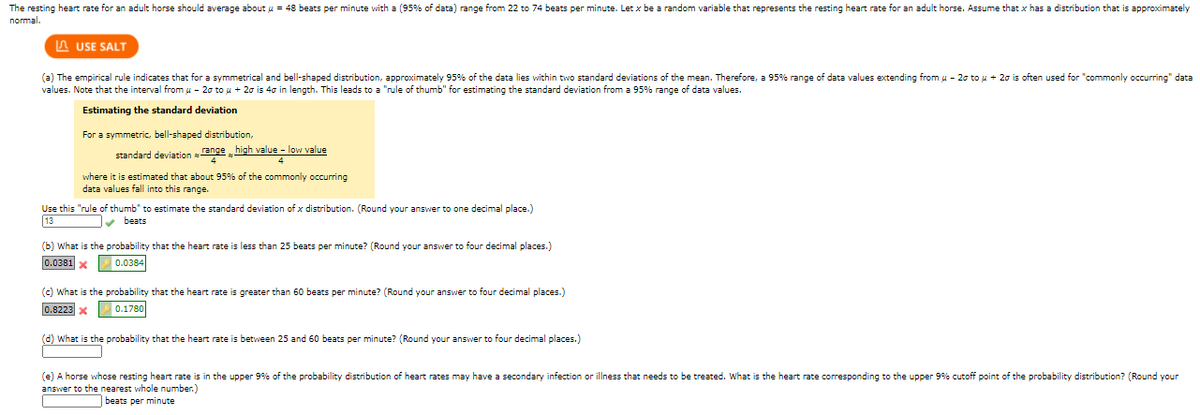(d) What is the probability that the heart rate is between 25 and 60 beats per minute? (Round your answer to four decimal places.) (e) A horse whose resting heart rate is in the upper 9% of the probability distribution of heart rates may have a secondary infection or illness that needs to be treated. What is the heart rate corresponding to the upper 9% cutoff point of the probability distribution? (Round your answer to the nearest whole number.) beats per minute
(d) What is the probability that the heart rate is between 25 and 60 beats per minute? (Round your answer to four decimal places.) (e) A horse whose resting heart rate is in the upper 9% of the probability distribution of heart rates may have a secondary infection or illness that needs to be treated. What is the heart rate corresponding to the upper 9% cutoff point of the probability distribution? (Round your answer to the nearest whole number.) beats per minute
MATLAB: An Introduction with Applications
6th Edition
ISBN:9781119256830
Author:Amos Gilat
Publisher:Amos Gilat
Chapter1: Starting With Matlab
Section: Chapter Questions
Problem 1P
Related questions
Topic Video
Question
(D) and (E)

Transcribed Image Text:The resting heart rate for an adult horse should average about u = 48 beats per minute with a (95% of data) range from 22 to 74 beats per minute. Let x be a random variable that represents the resting heart rate for an adult horse. Assume that x has a distribution that is approximately
normal.
A USE SALT
(a) The empirical rule indicates that for a symmetrical and bell-shaped distribution, approximately 95% of the data lies within two standard deviations of the mean. Therefore, a 95% range of data values extending from u - 20 to u + 20 is often used for "commonly occurring" data
values. Note that the interval from u - 20 to u + 20 is 40 in length. This leads to a "rule of thumb" for estimating the standard deviation from a 95% range of data values.
Estimating the standard deviation
For a symmetric, bell-shaped distribution,
standard deviation ange high value - low value
where it is estimated that about 95% of the commonly occurring
data values fall into this range.
Use this "rule of thumb" to estimate the standard deviation of x distribution. (Round your answer to one decimal place.)
13
v beats
(b) What is the probability that the heart rate is less than 25 beats per minute? (Round your answer to four decimal places.)
0.0381 x
0.0384
(c) What is the probability that the heart rate is greater than 60 beats per minute? (Round your answer to four decimal places.)
0.8223 x
0.1780
(d) What is the probability that the heart rate is between 25 and 60 beats per minute? (Round your answer to four decimal places.)
(e) A horse whose resting heart rate is in the upper 9% of the probability distribution of heart rates may have a secondary infection
answer to the nearest whole number.)
illness that needs to be treated. What is the heart rate corresponding to the upper 9% cutoff point of the probability distribution? (Round your
beats per minute
Expert Solution
This question has been solved!
Explore an expertly crafted, step-by-step solution for a thorough understanding of key concepts.
This is a popular solution!
Trending now
This is a popular solution!
Step by step
Solved in 2 steps

Knowledge Booster
Learn more about
Need a deep-dive on the concept behind this application? Look no further. Learn more about this topic, statistics and related others by exploring similar questions and additional content below.Recommended textbooks for you

MATLAB: An Introduction with Applications
Statistics
ISBN:
9781119256830
Author:
Amos Gilat
Publisher:
John Wiley & Sons Inc

Probability and Statistics for Engineering and th…
Statistics
ISBN:
9781305251809
Author:
Jay L. Devore
Publisher:
Cengage Learning

Statistics for The Behavioral Sciences (MindTap C…
Statistics
ISBN:
9781305504912
Author:
Frederick J Gravetter, Larry B. Wallnau
Publisher:
Cengage Learning

MATLAB: An Introduction with Applications
Statistics
ISBN:
9781119256830
Author:
Amos Gilat
Publisher:
John Wiley & Sons Inc

Probability and Statistics for Engineering and th…
Statistics
ISBN:
9781305251809
Author:
Jay L. Devore
Publisher:
Cengage Learning

Statistics for The Behavioral Sciences (MindTap C…
Statistics
ISBN:
9781305504912
Author:
Frederick J Gravetter, Larry B. Wallnau
Publisher:
Cengage Learning

Elementary Statistics: Picturing the World (7th E…
Statistics
ISBN:
9780134683416
Author:
Ron Larson, Betsy Farber
Publisher:
PEARSON

The Basic Practice of Statistics
Statistics
ISBN:
9781319042578
Author:
David S. Moore, William I. Notz, Michael A. Fligner
Publisher:
W. H. Freeman

Introduction to the Practice of Statistics
Statistics
ISBN:
9781319013387
Author:
David S. Moore, George P. McCabe, Bruce A. Craig
Publisher:
W. H. Freeman